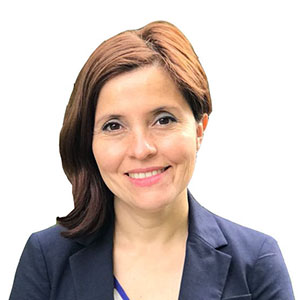What are you and your company doing to help reduce embodied carbon emissions?
Barbara Rodriguez Droguett, Ph.D.
Académica FAU, Universidad de Chile
After working for the CLF for almost four years, I finished my PhD and returned to my hometown Santiago, Chile. I went back to teaching at the School of Architecture at Universidad de Chile in the middle of an unprecedented social crisis. Conversations about Just Transition were taking place everywhere among academia, civil society groups, and the private sector as we were expanding our own discussions on long-term decarbonization strategies for the building sector. I was developing the contents for a graduate class on net zero carbon buildings for the Real State Masters Program and realizing at the same time, the enormous challenge we have ahead in achieving a zero-carbon society while balancing the environmental, social and economic variables.
I decided to accept a position at the Ministry of Energy, working to create a roadmap towards Net Zero Carbon Buildings in Chile with their Buildings and Cities team. The Chilean Government has made a commitment to achieve carbon neutrality by 2050, more efficient buildings play a key role as these can help achieve a substantial reduction of GHG emissions.
Chile, like all the Parties, subscribed to the Paris Agreement, must implement the necessary strategies to fulfill the commitments agreed in its Nationally Determined Contribution (NDC). The Ministry of Energy in Chile is carrying out a decarbonization plan of the electric matrix by 2040 that would bring a reduction of 7.5 MtCO2eq by 2050 and also the actions from a commitment to advance in the definition of Net Zero Energy Building (NZEB) for Chile.
We are currently co-leading the National Whole Life Carbon Roundtable under which we are developing a national strategy to achieve a carbon zero built environment by 2050. This initiative is developed in collaboration with leading public and private institutions in the construction industry. Some of the objectives in the short term (2020-2025) are to: develop the first embodied carbon benchmark for existing residential and commercial buildings, understand data needs and developing tools to assess whole life carbon in the industry.
Chile, like other countries is facing an economic crisis due to the COVID19 pandemic that will continue to require innovative solutions to overcome the challenges that our local economies face: In this sense, this brings many opportunities for decarbonization while achieving environmental stewardship, economic reactivation, and just transition.

Gerald Wilson
President and CEO, Autonomic Materials
I’ve been working in research and development in the area of self-healing polymeric materials for almost two decades. Initially, the appeal was the creative outlet this area of research offered—the opportunity to use chemistry to design various ways for polymers to exhibit autonomic repair after damage. As we designed self-healing functionality into polymers for composite, coating and biomedical applications, the potential of our technology platform to improve the longevity of polymeric materials in their respective applications and to decrease the consumption of petroleum feedstocks used to manufacture these polymers, became more evident.
Today, at Autonomic Materials, we are on a mission to leverage self-healing functionality to design coating systems that effectively protect assets from corrosion while minimizing the CO2 and volatile organic compound (VOC) emissions associated with the production and use of coating systems. The incorporation of our self-healing technology in the design of coating systems improves their performance. Coating systems incorporating our technology have demonstrated performance improvements of over 400% relative to incumbent systems in accelerated corrosion testing. This keeps them in service for a longer period of time, effectively resulting in a decrease in the number of painting activities and coating material consumption. Fewer painting activities occurring over the lifetime an asset translates to lower CO2 emissions associated with energy consumption during supply and value chain activities such as manufacturing of the coating systems, preparation of surfaces for coating and coating application. The ability of our self-healing technology to improve the performance of coating systems has also facilitated the development of waterborne coating systems, which because of their improved performance, can replace solvent-borne versions in a wide range of applications while eliminating the use of toxic VOCs and their greenhouse gas activity.
As we think about decreasing embodied carbon emissions, ensuring we use the best available technology and smart formulation design to develop longer-lasting and more eco-friendly coatings for the protection of our critical infrastructure is an important part of the equation. Helping asset owners and the architects and engineers that advise them to execute on this important responsibility is central to our reason for being.

Alana Guzzetta
National Research Laboratory Manager at US Concrete
I started learning about concrete in college as a civil engineering student participating in the ASCE (American Society of Civil Engineers) concrete canoe competition at San Jose State. Our team competed against other universities in the Northern California and Nevada region. The competition involved building a canoe made of concrete with a mix we had to design and then racing the canoe at a lake in the springtime….and yes, the canoe floats! Not only did that participation challenge me and grew friendships that have lasted long after college, but it was also a great stepping- stone to my current career. During the four years I participated in the concrete canoe competition, I learned about slag and fly ash and how they work in concrete to enhance durability and contribute to sustainability. When I graduated college, I had no idea how applicable that knowledge would be as I became a team member of a company that leads the way in sustainable concrete and is a founding member of the Carbon Leadership Forum.
In 2011 when I began my career in U.S. Concrete’s National Research Lab, Central Concrete (a U.S. Concrete company) had already made strategic investments operationally for the ability to carry three cementitious materials at each plant (cement, slag, and fly ash) in order to be able to provide the most sustainable concrete. The research lab and Central Concrete’s quality assurance team had already collaborated in using these materials to develop mixes with 50-70% cement replacement and optimized performance. Shortly after this Central Concrete was the first building material supplier in North America to provide EPDs (environmental product declarations) for its products. This is where I started learning about embodied carbon and how to incorporate sustainability metrics along with material performance properties for classification of mix designs.
Currently my team serves as the research resource for all of the U.S. Concrete business units through concrete testing, evaluation of new materials and admixtures for use in concrete, and mix design development for targeted performance and reduced embodied carbon. I have a passion for data and technical knowledge of concrete. Additionally, I have enjoyed new opportunities in the past 2 years to collaborate with architects, engineers, and sustainability consultants to assist with concrete specifications that are performance-based, discuss options that U.S. Concrete has available for optimized mix designs, and incorporate achievable embodied carbon goals for projects. Most recently I have joined the ACI 318 sustainability subcommittee.

Mark Chen
Senior Sustainability Engineer, Skanska USA Building Inc.
As a general contractor, I’ve been able to witness first-hand the carbon and resource impact of construction. What excites me is that this means there is a huge opportunity to improve on that impact and much of that opportunity lies in the embodied carbon of our construction materials. I’m fortunate to be in a position with Skanska where I can bring this conversation to the table with our building trades, manufacturers, designers, and clients, leveraging the EC3 tool to provide data and carbon reduction opportunities as we work through project design, procurement, and construction.
This is also why I’m proud to work for a company like Skanska, who not only conceived and co-developed the EC3 tool to track, manage and reduce embodied carbon emissions but has also set an ambitious company target of net-zero carbon emissions by 2045. With support from our Skanska teams, we’ve started important conversations around embodied carbon with industry partners and realized embodied carbon reduction wins on projects.








